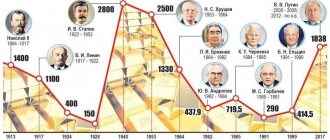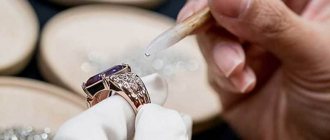Other articles
10 rubles of the new weight standard
By the end of the 19th century, the exchange rate of the paper ruble decreased by one and a half times in relation to the silver one, this was facilitated by the Crimean and Russian-Turkish wars, as well as the large-scale reforms carried out in the country. If not for the decisive actions of the Ministry of Finance, banknotes would have depreciated in the same way as bank notes did in their time. The second important factor of the future reform was the fact that many developed countries of that time had already switched to the gold and exchange system (England, France, USA, Germany, Italy, Belgium, Switzerland); by the end of the century, Japan, Hungary, and Argentina were switching to it. Russia still remained committed to the silver standard, which created obstacles in international transactions. Probably, if it had not been for the transition to the gold standard, which made it possible to boost the Russian economy at the beginning of the 20th century, there would not have been a collapse of the monetary system in the First World War.
Preparation of reform
S.Yu. Witte in the painting by I. Repin
Minister of Finance M.Yu. began preparing the reform. Reitern back in the late 1870s, then his work was continued by ministers N.H. Bunge and I.A. Vyshnegradsky, and since 1892 S.Yu. Witte, who managed to implement all the ideas by 1898. In addition to Witte's talent, favorable factors were the growth of industry and agriculture, and the construction of railways (including the Trans-Siberian Railway). The silver standard system that existed since the 1840s meant that all payments had to be made in silver rubles or other silver coins of the same standard. Copper coins, although they were firmly tied to silver coins, were considered as change. They might not be accepted for large payments, as taxes, etc. The same applied to gold coins, despite their high purchasing power. Paper notes were an alternative form of money that had a floating rate, regularly set by the government. Any government need for money led to the printing of new notes, which could not be fully backed with silver. Queues arose at the cash registers, restrictions on exchange were introduced, all this could not but reduce confidence in paper money, and therefore led to a drop in value. That is, credit cards, despite all the actions of E.F. Kankrin in the 1830-1840s found themselves in the same position as the earlier banknotes. The first thing that had to be done to implement the gold coin system was to create a large stable gold reserve. The greatest success in this was achieved under the Minister of Finance I.A. Vyshnegradsky, when the gold reserves almost doubled, reaching 645 million rubles in gold. In 1893-1894, additional duties were introduced on the import and export of credit notes, and a customs agreement was concluded with Germany. By 1897, the country's gold reserves reached 1.095 billion rubles.
What is the backing of the Russian ruble today?
Although Russia has been steadily accumulating the country's gold reserves over the past decade, these reserves are not enough to fully back the ruble. The factors that support the current ruble are foreign currencies, mostly the US dollar, and energy resources.
However, in conditions of economic pressure from OPEC, Russia needs alternative solutions.
Is the ruble currently pegged to gold?
Today's ruble is not tied to gold; the country's reserves in precious metals, in all its magnitude, can barely cover 5% of convertible currency.
However, recent discoveries by chemists in gold mining have significantly reduced the cost of extracting gold from ore, which can significantly accelerate the build-up of the country's reserves.
Introduction of the gold standard
Trial imperial 1895 (exhibition at the Goznak Museum)
In February 1895, the reform project was approved by Nicholas II, after which a series of decisive measures followed. From May 8, it is partially permitted to make payments and enter into transactions in gold coins (from November - fully permitted), and banks begin issuing gold accounts. In June, the State Bank and some private banks begin to accept gold coins from the population as deposits. In December, the exchange rate for banknotes and gold coins is set: 7 rubles 40 kopecks for 5 rubles in gold. Later it was reduced to 7 rubles 50 kopecks, that is, 1:1.5. In preparation for financial changes, new coins were developed. It was necessary to most gently, without popular unrest, replace the old 5 and 10 gold rubles with new ones with a reduction in weight by one and a half times. At that time, a coin with a face value of 10 rubles was called an “imperial”, and a coin of 5 rubles was called a “half-imperial”. Test coins were produced with a denomination in imperials, equal in size and weight to the old gold coins, but indicating the number of new rubles. In addition, other attempts were made, for example, they wanted to call the new depreciated ruble “Rus”. Test coins with denominations of 15, 10 and 5 russ are known. However, all this was abandoned, and in 1897, under the signature of Nicholas II, a large circulation of 15-ruble coins came into circulation, as well as coins with a face value of 7 rubles 50 kopecks, which had the same pure gold content as the old 10 and 5 rubles, respectively. They were minted for only one year, after which 5 and 10 rubles of a new weight began to be produced.
Test coin 15 russ (Hermitage exhibition)
The population as a whole accepted this transition calmly, since the changes affected only the gold coin, which was available in small quantities. Silver and gold coins remained the same, and the old credit notes were replaced by a new paper ruble with a clear indication of the gold content. Old credit notes were declared invalid and freely exchanged for new ones in a ratio of 1.5:1. Gold 10 rubles of the old type were exchanged for 15 new ones of the same weight. Thus, the state managed to completely eliminate the internal debt to the population and guarantee the stability of the ruble in subsequent years. In 1898, new credit notes were issued in denominations of 1, 3, 5, 10, 25, 100 and 500 rubles. A year later, a 50 ruble banknote was issued. All paper money of the new type contained an indication of the content of pure gold and mandatory exchange without limiting the amount.
7 rubles 50 kopecks (exhibition of the Goznak Museum)
Basic provisions of the new monetary system:
- all payments were to be made in gold rubles, all deposits were also accepted only in gold; - the paper ruble had a gold backing equal to 17.424 shares (approximately 0.76 g) of pure gold; - the exchange of credit notes for gold coins was carried out freely at any branch of the State Bank; - silver and copper coins became additional means of payment and could have some restrictions; - a silver coin could be used to pay no more than 50 rubles of the total amount; - the entire mass of credit notes had to be 50% backed by gold, and in case of growth over 1 billion rubles - in full; - all pre-reform loans remained the same and were repaid with new rubles.
Rare Russian hundred francs
Collectors are interested in rare gold coins with a non-standard denomination of 37.5 rubles, which are called “Russian hundred francs”.
They were released in 1902 in a very small edition - only 225 pieces. Today, historians and numismatists do not have a common opinion regarding the purpose of these coins, because they have never been in wide circulation. There are three versions regarding their purpose:
- economic;
- award;
- gambling.
Some researchers believe that the unusual gold hundred francs were released in a small batch for testing. In the future, they were planned to be widely used for transstate transactions between the Russian Empire and France. This period coincided with the heyday of close cooperation between the two states in the Far East. But the money did not enter circulation.
The second version, which inspires more confidence, is this: rare rubles could be used as rewards or collectibles. They were expected to be distributed among the upper class as expensive gifts for guests. This version is supported by the fact that two hundred of the minted gold coins were given to Empress Alexandra Feodorovna. And the remaining 25 pieces were received as a gift by Prince Georgy Mikhailovich. In 1903, ten more coins dating from 1902 were issued, which were solemnly presented to Prince Vladimir Alexandrovich.
In 1904, the last, 236th gold coin with a face value of 37.5 rubles was minted, especially for the Hermitage collection.
According to the third version, such coins could be used to play in a casino. But this hypothesis does not have serious confirmation.
Results
1 ruble model 1898
Despite the fact that, in general, the monetary reform passed smoothly, it was not received unambiguously. And it is not surprising, because only those who kept their savings in gold, silver, copper, or in the form of bank deposits received the winnings. The bulk of savings was in paper money, which depreciated by one and a half times. On the other hand, the owners of credit notes already understood that their money supply could not be valued higher than 2/3 of the face value, since there was a stable exchange rate. However, the population received new money, which was not subject to any restrictions. It became profitable to keep credit cards; they were accepted for all payments. By 1897, almost all paper money in the country (about 1.1 billion rubles) was backed by gold, which, translated into new money, amounted to only 700 million. That is, the gold backing was more than 100%, so on August 29, a decree was issued to lower the level of backing new banknotes to 600 million. In 1899, the bar was lowered to 300 million. That is, everything above this amount had to be fully covered by gold reserves, and everything below - at least 50%. Internationally, Russia has become convenient as a trading partner, the ruble has begun to be converted on stock exchanges. The economy grew rapidly and became one of the strongest in the world. The gold backing of the ruble exceeded the money supply, and exchange for coins was carried out freely. But the outbreak of the First World War completely upset the monetary system, gold reserves were rapidly melting, and the exchange rate of the paper ruble was declining. One of the reasons for this is considered to be the gold standard, which turned out to be highly dependent on the economies of other countries with a similar monetary system.
Article last modified: 06/12/2018
Other articles
Reasons for canceling chervonets
At various points in history, most often during a crisis, precious metal coins had to be temporarily withdrawn from circulation. Securing money with gold has many advantages, among which the main ones are high density, small storage volume, stability, uniqueness and other qualitative characteristics of the precious metal.
However, later gold coins had to be abandoned completely for a number of reasons:
- Chervonets of high standard had increased softness, were easily scratched, and deteriorated when frequently checked for authenticity by biting. Coins were often lost, which upset the balance of free circulation of money.
- The rapid growth of trade turnover could no longer be ensured by minting coins in the required volume.
- The large weight and small volume are convenient for storage, but caused a number of inconveniences during transportation. Even a small purse of gold was extremely weighty.
This led to gold being kept in the treasury, and paper money becoming a kind of certificate for it. After the abolition of the standard in the United States (1971), almost all countries abandoned their currency peg to gold.
What will happen if the ruble is tied to a precious metal: critics’ opinions
Experts in their comments on the return to the previous system sometimes express directly opposite opinions. Some advocate for reinforcing the Russian ruble with gold - fortunately there are reserves and deposits. Others appeal with hard facts and refute the very possibility of such a scenario.
Anton Tabakh, a commentator for Forbes magazine, believes:
“The need for self-restraint will most likely be the main factor preventing the transition to the gold ruble, which, quite possibly, would be useful for the population and business.”
The modern economic encyclopedia contains data that pegging the ruble to gold will ultimately lead to a shortage and an increase in the price of money itself as a fact due to the limited possibilities of their issue, which in turn will lead to a decrease in production and an increase in unemployment. There will be an abundance of goods, but there will be nothing to buy them with.
According to the vice-president of Z.M.D. A. Vyazovsky, “gold is an excellent investment instrument, but a return to the old days, when it served as a means of payment, is hardly possible.”











